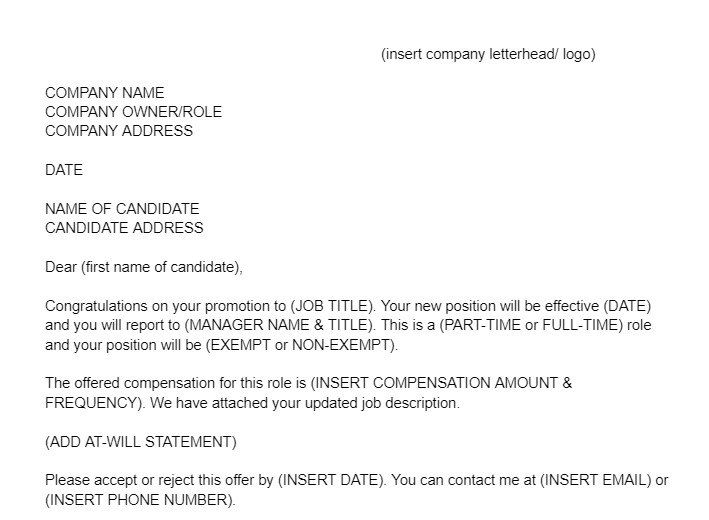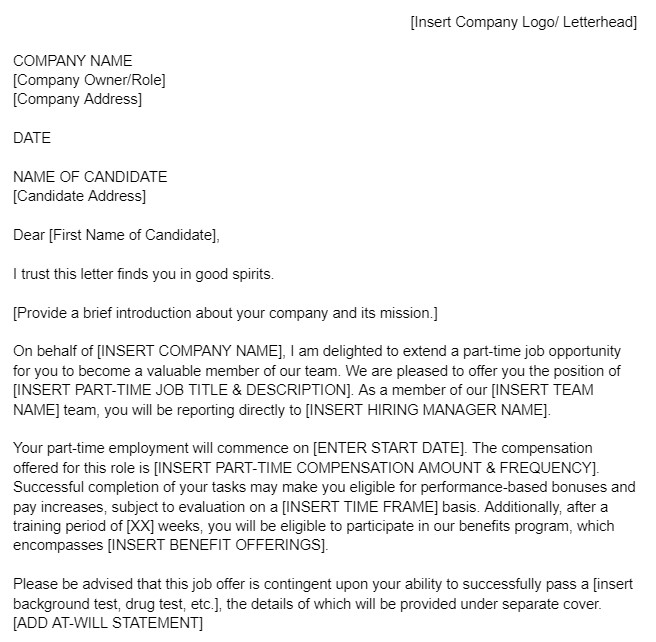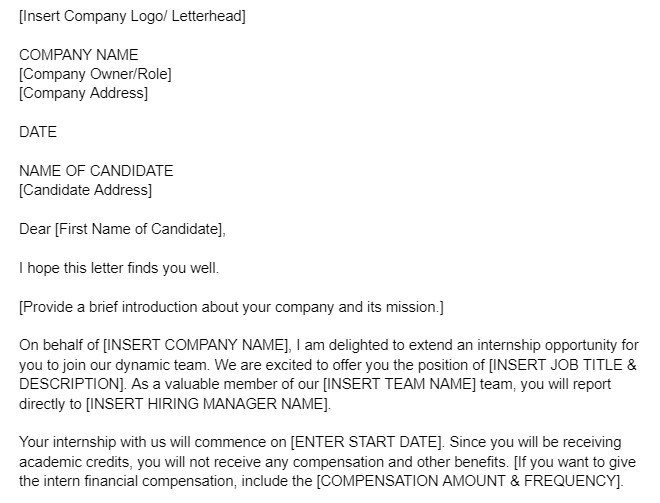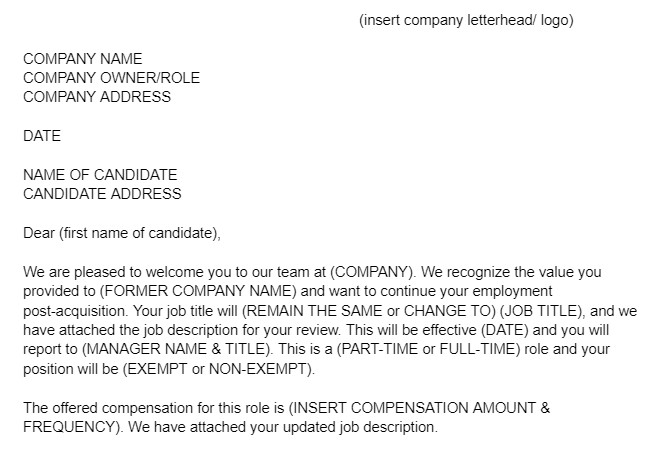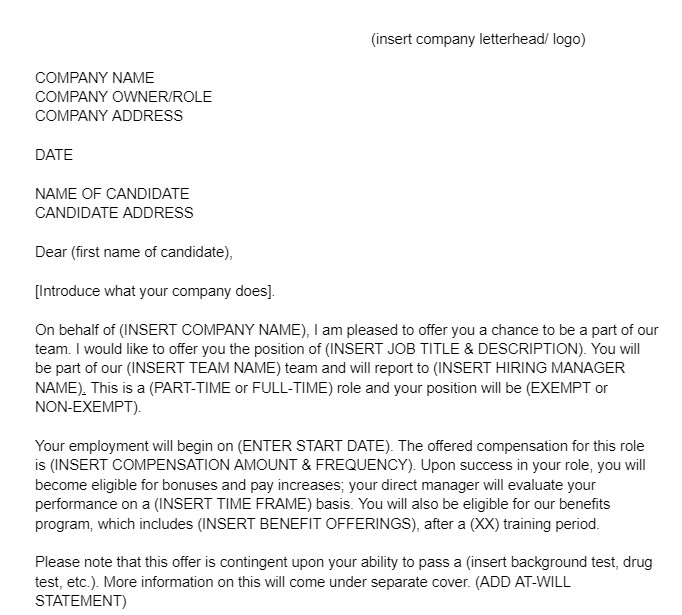
Thank you for downloading
Need help creating an offer letter template? Gusto allows you to create and customize your job offer template with just a few clicks.
An employment offer letter formally documents any verbal job offers and clarifies details discussed during the interview process. It typically includes basic information, like the job description and compensation—but the true goal is to ensure both parties are on the same page about the offered role’s expectations and responsibilities. Offer letters should also clearly state the benefits of the role, making it easy for the recipient to accept.
We’ve created a standard offer letter template and several alternative templates for different hiring scenarios, which you can access by expanding the sections below. You can personalize and use these templates to simplify the process of offering a job to your chosen candidate.
If the merger or acquisition is a stock purchase where employees are absorbed by a new entity, existing employment forms may continue to be used. If there are any changes that need to be addressed—like company policies, benefits, or change in job duties or pay—then use this template. In an asset sale, however, the employees of the selling company are often terminated and then rehired by the new company, in which case you should use the standard job offer template.
If you need help crafting a legally binding employment contract after your candidate accepts the job offer, consider Rocket Lawyer. It has ready-made employment contract templates for each state. You can create a contract for your new hire in as little as three steps.
What to Include in an Offer Letter Template
An employment offer letter should be specific to the company, industry, and type of role. However, there are a few elements that are usually included in a formal offer letter, including:
- Candidate’s name
- Company name and logo
- Job title and description
- Compensation
- Benefits summary
- At-will statement
- Offer contingencies
- Start date
- Offer period
- Method of acceptance
- Disclaimer
Tip: When sending an offer letter via email, attach the letter—don’t just write in the email.
Start each offer letter with the date, a salutation, and the candidate’s full name. If provided, include the candidate’s address (either physical or email). The beginning of the letter will set the tone of the offer and should mirror your corporate culture, so start with something enthusiastic but professional.
Make sure the company name is clearly identified at the top of the letter. Drafting the offer letter on official company letterhead that includes the company logo will make the letter look more professional and signal to the recipient that it’s a legitimate offer.
Include the formal job title so the recipient knows exactly what is being offered. This should match the job title used throughout the hiring process; if there are any differences, the letter should explain why the title is different. Likewise, the letter should identify the reporting structure for the role, provide details about general responsibilities, and state whether the role is full time or part time, office-based or remote, and exempt or nonexempt.
The offer letter should also include a copy of the job description. It’s good practice to have the candidate sign the job description as well, indicating their understanding of the position and noting their ability to do the core duties as outlined.
Once you provide the job title and a brief description of the role being offered, detail how the employee will be compensated. This section of the offer letter should state the annual salary, per-pay-period salary, or hourly wage and how frequently the employee will get paid—weekly, semimonthly, or otherwise. You can also use this portion of the employment offer letter to describe any additional compensation like commission, equity, or performance-based bonuses.
Get and compare compensation data easily using a salary comparison tool. Here are our top picks for the best salary comparison software.
A job’s benefits package is, in many cases, just as important to candidates as the salary. For that reason, it’s important to include a snapshot of benefits with the offer letter (a more detailed summary of benefits should be in the official employment contract and your company handbook).
If you have access to summary documents from your company’s benefits providers, you can also include this as an attachment when sending the offer letter. Also, note if there is a waiting period before any of the benefits take effect.
Where applicable, you can include general information about benefits in the offer letter, to include:
- Insurance coverage
- 401(k) plan
- Paid time off
- Flexible spending accounts
- Educational assistance
- Flexible work schedule
- Work from home option
At-will employment means that a company or employee can terminate employment at any time and for any non-discriminatory reason. Every state is at-will except Montana, so if your business (or new employee) is not located in Montana, you can include at-will language in your offer letter.
As with the benefits summary, many employers choose to reserve this language for the employment agreement. Either way, we recommend you work with a legal professional to ensure you include all necessary language.
It’s important to note that an at-will statement is only part of the process of retaining an employee’s at-will status. Your company and managers must also treat the employee as an at-will employee. If you provide the employee with a written employment agreement, for example, and that agreement refers to their position as permanent or provides listed reasons for termination, then you may be bound by those listed reasons, and terminating the employee for any reason not listed could result in legal action.
Job offers contingent on any further reviews or requirements should list these items clearly and in an obvious location so the recipient is guaranteed to see them. Depending on the type of job, this may include a background check, credit review, drug test, or other evaluations.
If there are contingencies, you should also include information about the next steps and whether you require any immediate action from the candidate. Failing to list contingencies in an offer letter could make it difficult to withdraw the offer if the candidate does not pass your initial requirements.
Often, a hiring manager will discuss the employee’s availability during the interview process. However, an official start date should be identified in the offer letter even if you already discussed it with the candidate. If the start date is dependent on offer contingencies, state that in the letter and provide the date by which those additional requirements must be met.
Offer periods are important because they give candidates time to consider the job offer, discuss it with family members, and compare it with competing offers. Requiring a recipient to respond within a certain period also keeps the hiring process on track and enables you to move on to other candidates if your first choice declines. In general, offer periods range from 24 hours up to one week—but you can always choose a period that makes sense for the role and hiring timeline.
In addition to letting candidates know how long they have to accept an offer, provide details about how they should accept or decline the offer. Including this information in the offer letter gives your potential employee a sense of confidence and security around the acceptance process while ensuring you don’t miss their response. Regardless of how you prefer candidates respond, always provide the relevant contact information, whether it be your phone number or email address.
Finally, include a section in the offer letter explaining that the letter does not serve as a binding employment contract. It is also a good idea to include an equal opportunity employer statement. An attorney can help you draft this portion of the letter and review the offer in its entirety to ensure you’re not including any contractual language.
When & How to Send an Offer Letter
An offer letter signals the beginning of the onboarding process. It’s best to speak with the candidate before having your HR team draft one from an offer letter template.
Many companies opt to do a verbal offer—which isn’t as official as a written letter, but it allows the hiring manager to gauge the candidate’s interest. Is the salary you have in mind too low? Will the candidate try to negotiate? How much notice do they need to give their current employer? Knowing these things beforehand will prevent you from having to adjust the letter later.
Once you talk to your potential employee about the offer, send an email with the full offer details as a PDF attachment. In addition to the offer itself, attach any relevant documents that might help them make a decision—such as benefit plan documentation and company policies. This is also a good opportunity to streamline the onboarding process by providing documents the employee needs to complete before their first day.
Where possible, an offer letter should be sent by the hiring manager for the role. This demonstrates to the recipient that the offer is official and represents the company’s willingness to enter into an employment agreement. However, if the candidate has been interviewing with another team member—or if the company’s owner prefers to send offer letters—this is acceptable too. The most important thing is to make the offer clear, concise, and professional.
What to Do After Sending the Offer Letter
With luck, your candidate will accept the job offer immediately. But in many cases, the initial offer may not be the end of the road. For that reason, hiring managers should expect to field questions from the candidate about benefits and other details of the offer. A hiring manager should also prepare to negotiate the terms of the offer—whether it be compensation, vacation time, or other benefits.
To learn more about the other steps you should follow when hiring an employee, check out our guide on how to hire employees.
Employment Offer Letter Frequently Asked Questions (FAQs)
A standard offer letter is a document stating your intent to hire an employee based on the terms and conditions laid out in the offer letter. The letter outlines the details of the role along with benefits and information about your company and its policies. By signing the letter, the candidate indicates their agreement with the terms of the letter.
Absolutely. Use one of our free templates to help you get started and change the letter so it aligns with your company culture, making it more or less formal. Whether you use our template or you create your own, we do recommend you keep the offer letter to one page, plus any attachments like the job description and bonus structure.
We recommend that you create your offer letter as a document that’s attached to the email sent to a candidate. You may also send the offer letter from an online signature software so that your candidate can accept and sign the offer letter electronically. Do not write your formal offer letter in the body of the email as it may not have the full force and effect of a traditional letter.
Yes—but it is not a contract. While both documents require the candidate’s signature and yours, a contract is a more formal employment document, laying out complete details of the role and responsibilities, including the employment period. In contrast, an offer letter includes details of the role, but with brevity and without an obligation of time.
Yes—if an offer has not been accepted, you can revoke the offer at any time. If the offer has been accepted, you can still revoke the offer, but you may need a qualifying reason to do so, like the failure of a background screen as noted in the offer letter.
Bottom Line
Use an offer letter template to prepare and send a formal document to the candidate you wish to hire. It sets the tone for the onboarding process and helps the employee understand what to expect moving forward. To ensure candidates have the information they need, draft the employment offer letter with important details like a job description, compensation and benefits, and how to accept or decline the offer.
